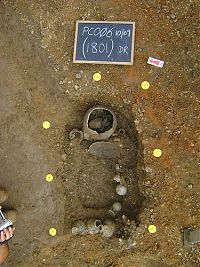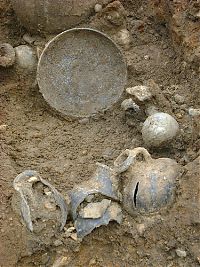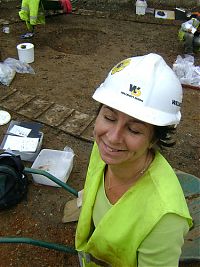A Cremation of Some Importance
- By: Ruth Rolfe |
- Sep 16, 2008
- Share
- del.icio.us

At the beginning of the week, Lorna asked me to write a blog. My heart sank. What on earth was I going to write about? For three days I had been on my hands and knees cleaning back areas that had previously been cleaned, got messy and needed cleaning again. I was just an itsy bit bored and there was no way I could make this job sound interesting. However, before I could get around to doing my blog, Chaz asked me to have a look for the cut of an urn and it’s relationship with a ditch feature running alongside it. I had had my eye on this particular urn for a while, so I was really pleased to get started on it. Little did I know what was in store.
Unfortunately the urn had met with misfortune and had it’s base knocked clean off (it had been inverted when deposited). This did however reveal what was inside – a cremation. I thought it would be a simple case of defining the cut and removing the urn. After a few minutes my trowel hit something metal…mmm, interesting. Perhaps it’s a coffin nail…no hang on, the cut’s too small for a coffin. Hey! What’s this? Red, white and blue? Not colours often seen in a Roman context. What ever it is, it’s very thin and shallow, looks like a plate.. What’s this next to it? Oh it’s a glass vessel, very thin. Whoops! Yes, very very thin! Oh and there’s another… and another. And this is how it continued. With every scrape of the trowel I found a nail, a ceramic pot, a glass vessel, an iron fitting, more pots, cremated bone!
I went back to the plate “thing” and revealed some more of it. It was beautifully patterned with a very fine, intricate, repeating design that although geometric, looked sort of floral. It was so thin that it could not be ceramic – so what was it? Enamel? Glass? Who knew? As the day wore on, it became apparent that what I was uncovering were the remains of a cremation and its associated goods. A wooden chest with iron nails and fittings had been placed into a pit dug into gravel. Along its East and West sides, ceramic jars and flagons (one with a deliberate slit in its side resembling a money box) had been arranged. On top of two of these was the inverted cremation urn. Inside the chest was a further cremation, probably in a small wooden box with three glass vessels along one side. And, at its Eastern side, most fantastic of all, was a complete glass millefiore dish in red, white and blue. This was a cremation of some importance.
The dish was carefully lifted and taken immediately to the Museum of London, who declared they had never seen anything like this outside of a textbook! So, not only did I now have something to write about, but I had just uncovered the richest cremation I am ever likely to work on…perhaps I should get out of archaeology now, while I am ahead!


